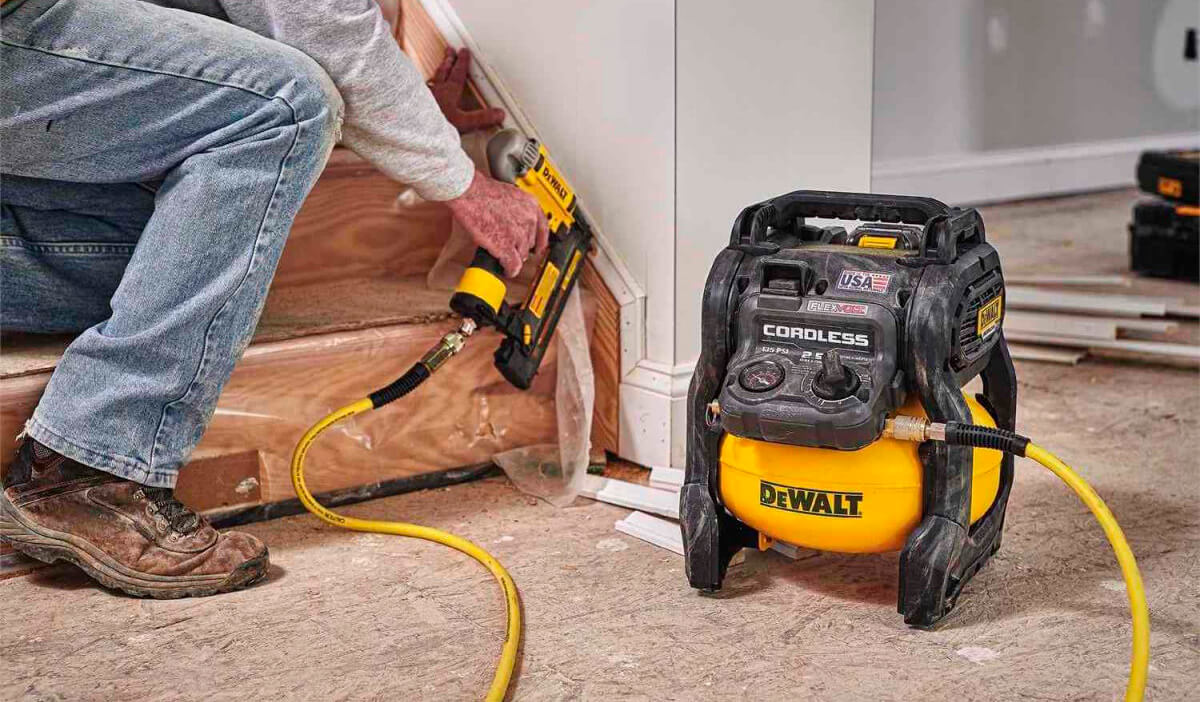
If a user is lucky enough to own best portable air compressor, he/she obtains a tool with a wide variety of functions. It’s first but not last purpose is to air up tires. The air compressor also facilitates cleaning stubborn surfaces like a pool deck or a driveway, for example. Pining is another purpose. Just mount a spray gun and pint various surfaces fast and hassle-free.
The following information will help pick the best portable air compressor depending on the purpose of use – whether it’s required to power machinery or pneumatic tools, or maybe just inflate tires. One can find out a model with a tank or a more compact and less noisy thankless modification.
The portable air compressor reviews below introduce models with various pressure and volume, reciprocating piston, and rotary screw constructions. Besides, the units come with different horsepower that is usually in the range of 1.5–6.5 HP. Also, it is possible to pick a model with the appropriate volumetric flow and portability, as well as the source of energy – whether it will be an electric or mobile model with gasoline or diesel engine.
Portable Air Compressors Reviews
PORTER-CABLE C2002
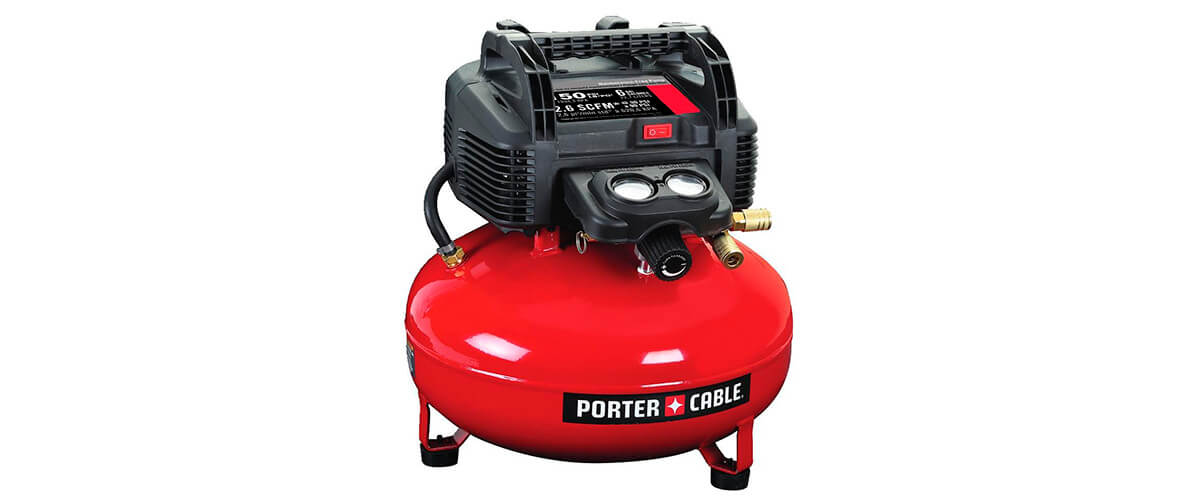
The PORTER-CABLE C2002 is a 6-gallon model that can be considered as one of the top rated portable air compressors that comes with the pressure regulator to control the output pressure. The C2002 features the induction engine to ensure its long lifespan and flawless performance. Its maximum pressure reaches 150 PSI and that’s enough to use air for a long run.
In order to blow outlines, it’s necessary to set the pressure of this tool using the regulator based on plastic water line ratings. Also, this model features quick-connect fittings, however, they require an appropriate adapter. The model also works well with pneumatic tools and a framing nailer.
The replenishment of the air is easy since it’s necessary to plug it into any AC power outlet and flip the red on a switch to start the motor. Once it reaches “full” 150PSI, it shuts off automatically.
Before the first use, it’s crucial to run the unit with the pressure valve open for at least 15 minutes and then close the valve allowing the tank to come up to the required level of pressure. By the way, its release valve is plastic and can be replaced as required.
Pros
- The model comes with the rubber footpads that prevent it from vibrating excessively.
- It builds up pressure fast and doesn’t need to run for very long to keep constant pressure.
Cons
- The PORTER-CABLE C2002 is rather noisy as it’s rated at 82 dBa and that’s louder than common competitors.
- It needs 15 minutes break after each hour of use in order to cool down.
Makita MAC2400
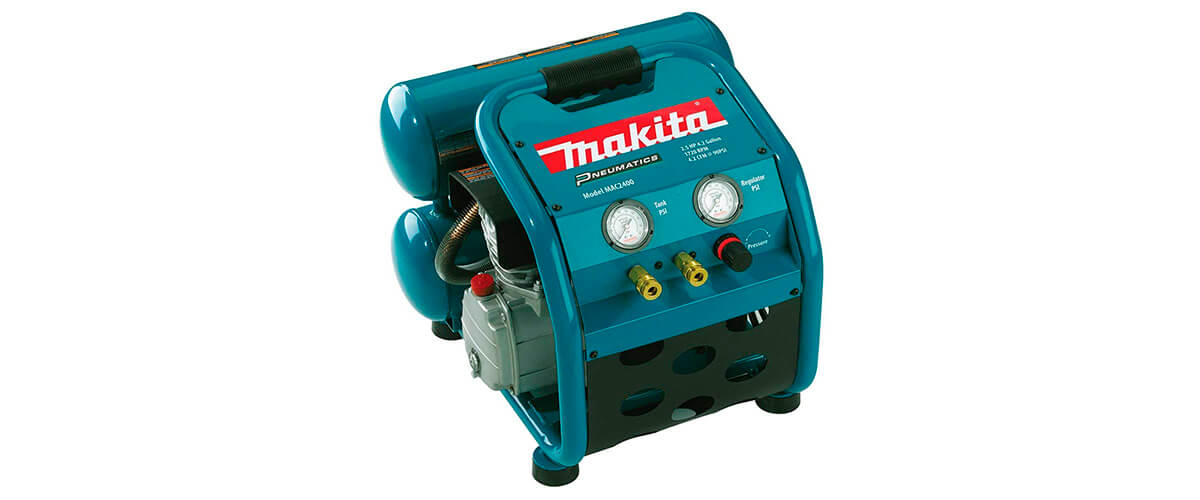
These small air compressor reviews cannot dispense the electric-powered, 4.2-gallon Makita MAC2400 with 2.5 HP that’s remarkable for its high durability due to the cast iron pump and solid crankshaft that help reduce any erosion occurrence. Such features make it similar to industrial models and provide efficient nailing and fastening. The unit also has the copper discharge tubing that spreads heat out when the assembly is working hard.
Its AMP draw reaches near 13 amps during the startup. In cold weather, it pops the breaker at 15 amps. Note that the size and length of the extension cord influence the unit’s work. For example, 12ga cords are perfect. The unit comes with two nozzle outputs to plug two hoses at the same time.
The unit works well on residential and lightweight commercial use (to inflate car tires, power pneumatic tools) since its average air tank’s volume doesn’t fit broader applications (filling up air on tractor-trailer rigs, for instance).
Pros
- It’s quiet and vibration-free.
- It’s an oil-lubricated model that enhances the compressor’s durability.
Cons
- It’s rather heavy – 77 lbs.
- The cart comes with 4-inch polyurethane wheels, but the wheels had no brakes. To solve this issue, the buyer should replace them.
Bostitch BTFP02012

When looking for the best small portable air compressor, pay attention to the Bostitch BTFP02012. It fits DIY projects since reaches 6 SCFM of air at 90 PSI. The unit features 0.9 HP subject to the normal operation. For example, it has plenty of power for hardwood floor installation.
The unit isn’t heavy and has an ergonomic handle on the top to move it around without efficient efforts. The turn off/on button is on the right side of the handle that’s also very convenient. The plastic panel with controls is well constructed to make all the indicators on it visible when standing above the unit. The vintage-looking dials are large and easy to read. The outlets are automatically sealed and they start “opening” when you plug in a hose with the appropriate male connector. So, there’s no need to put a cap on the second coupling if using 1 of the 2 outlets.
It’s a reliable product since it shows no leaks even with the hose attached over a couple of days.
Pros
- The air tank is getting filled and builds up pressure very fast.
- It has a dual connector to use two tools without disconnecting and reconnecting them.
- Rubber feet protect floors from damage.
Cons
- It lacks a basic accessory set, including tubing.
- It provides tighter and more reliable linking with the Bostitch nailers and they are more expensive.
PORTER-CABLE CMB15
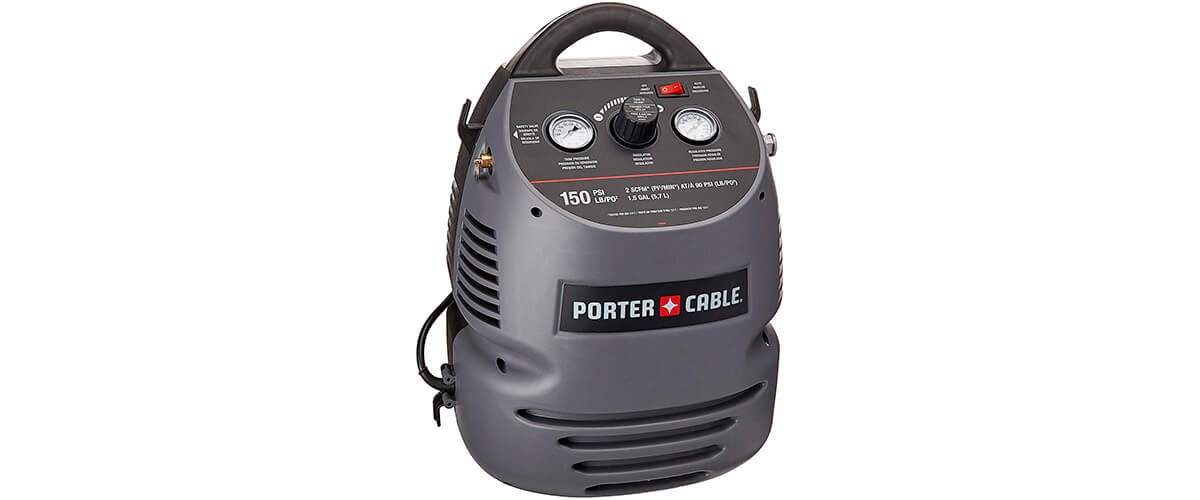
When wondering what is the best rated portable air compressor, think of the PORTER-CABLE CMB15. It’s portable, very lightweight, and produces noise within reason. It comes with an oil-free pump that facilitates its maintenance. Its small dimensions, as well as just 1.5-gallon tank, doesn’t allow using it for a wide range of applications but still, it performs flawlessly within its opportunities.
It doesn’t leak air, the regulator and gages work without an issue. One can let the air out very slow or very fast and the dedicated regulator works properly. If leaving 125 PSI in the compressor for 3 days it will lose just about 2 PSI.
This model runs more straightforward tools – a nail gun, pin and brad nailers, and stapler but not a die grinder or a drill. In general, it is able to power the majority of the low SCFM tools like pneumatics. If performing such specific tasks as blowing filters and parts on lab instruments, it’s necessary to buy different accessories to accomplish that work as they never come in the package.
Pros
- It’s easy to add quick-disconnects to the hose and the compressor to avoid damaging when storing in confined spaces.
- It works with RV tires since some other similar models can handle only car tires.
Cons
- The unit isn’t balanced well and fall over sometimes. Besides, the rubber feet forms small faint trace.
- This model lacks a compartment to store air blower and some other attachments.
DEWALT DCC2560T1
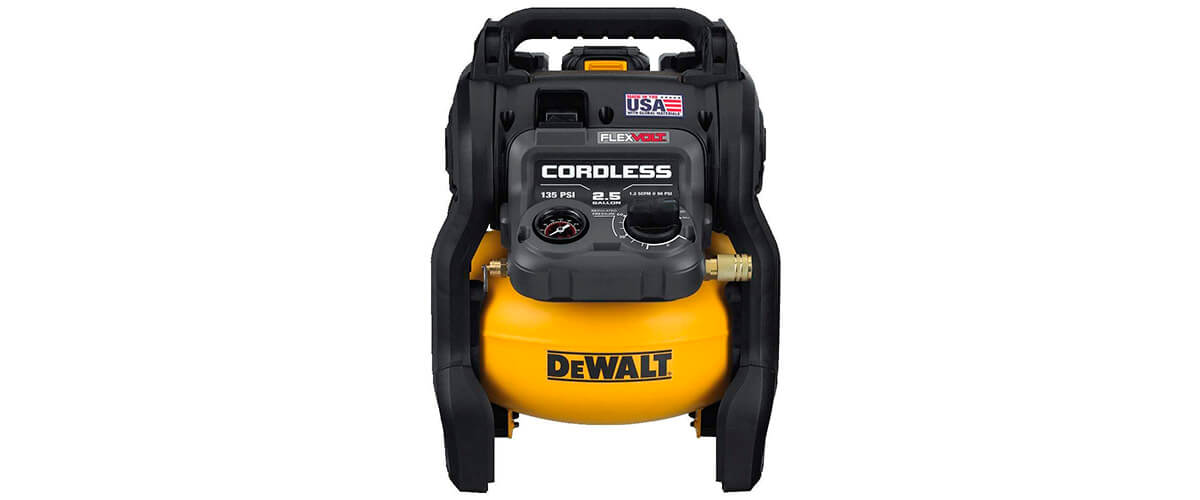
This portable air compressor review tells about a compact battery-powered model that needs no power cord and is convenient both for shop or home use. The DCC2560T1 is equipped with a small and light brushless engine that runs at 3,400 RPM and produces less heat and friction. Besides, it is notable for efficient energy consumption.
It’s a thoroughly constructed tool as its on/off dial is dust-sealed and comes with a protective hood over top. This model features a pressure regulator to adjust the tool side pressure.
The unit is remarkable for its atypical single-dial system that means it comes with a single tank pressure gauge. In plenty of the models, the discharge gauge and a regulator are located separately, but in this unit, they are in the same set and work as a simple dial to regulate the outlet pressure.
This model is good for trim work and plenty of other small applications, but it doesn’t perform well as a blower or if doing anything that takes more air volume and a larger tank, as a result.
Pros
- It doesn’t leak down.
- The compressor comes with the fast charger in the package.
- The chasses is convenient as it’s squared off on the back to be laid on it for travel.
Cons
- The unit reaches only 3–5 fills per battery charge that’s why it’s better to keep charger around.
California Air Tools 8010
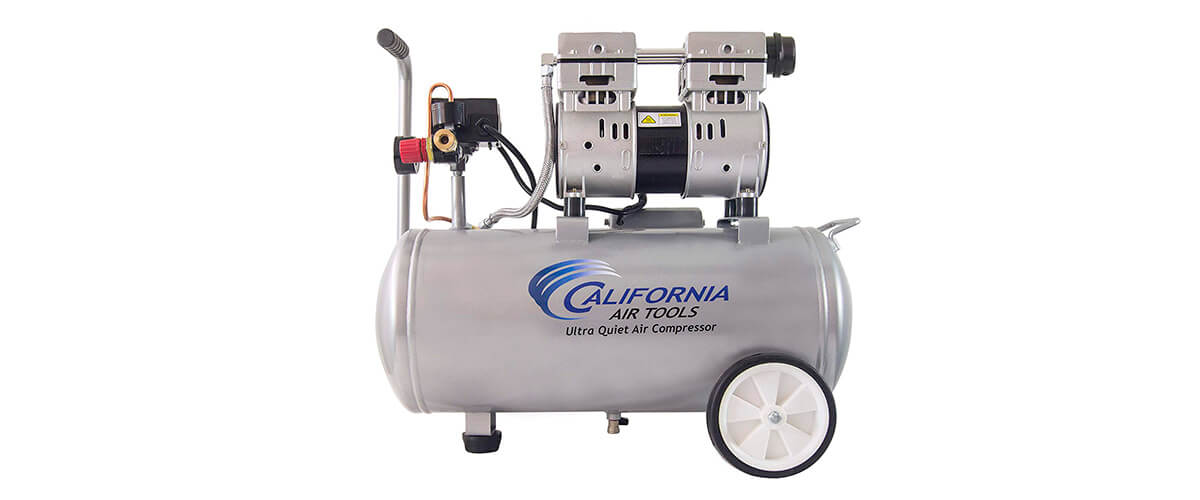
This electric-powered steel assembly can hardly be placed in a row with other small portable air compressors as it weighs 54 pounds. However, it worth attention due to its 8-gallon air tank and ultra-quiet operating that makes the unit perfect for indoor use.
The unit also features a straightforward pressure regulator: it requires pulling the knob out and rotating clockwise to increase output pressure to an accessory or to turn counter-clockwise to reduce it. Then just push the knob back in when done and that’s all. The engine is fitted with a large heat sink on it that allows filling the tank fast. Note that since the heat sinks might be rather hot, it’s possible to drape the hoses over.
This model can be used for a wide array of applications – with a brad nailer, for blowing out lawn tractor air filter or topping off tires, for example. Since it’s not a piston model and it uses a diaphragm setup, it fits only low-pressure applications. The unit demonstrates slow recovery and it’s not able to provide a high volume of high-pressure air. These specs makes it do sandblast, spray-painting large areas (a house, for instance), operating air grinders or sanders very slowly.
Pros
- The unit’s coupler is compatible with both automotive and industrial connectors.
- The compressor’s wheels move smoothly and quietly that is crucial considering its weight.
Cons
- The tank pressure indicator is on the front, facing forward instead of up that hampered its reading.
DEWALT DWFP55126

When speaking of the best mini air compressor, the DEWALT DWFP55126 couldn’t be ignored as it’s produced with a high-efficiency engine for flawless start-up in low temperatures or with the extension cord applications. Two users can work with this model simultaneously due to its two versatile couplers. However, consider that the couplers are industrial styled only.
The DWFP55126 fits large projects since it enables long tool run time with fast recovery. It works with the average noise level and comes with the console lid to protect controls. This cover is removable to provide easy repair if needed. The unit also comes with a drain that is easy to access. Note that as it is placed not in the center bottom where the water/condensation accumulates, but rather on the side of the tank, it’s necessary to drain it, pick it up and tilt it, and only then open the valve.
This model features 2.6 SCFM that means average air consumption. It’s enough for such types of work as driving nailer/stapler tools, but still, it requires more gallons for continuous operation without recharging.
Pros
- The unit doesn’t leak: it can lose just up to 10 PSI for 3 weeks.
- It’s able to pump up to 165 PSI.
- It’s carrying handle is very sturdy.
Cons
- It’s too small for spray painting – whether it deals with a house or just furniture.
Buyer’s Guide
Portable Air Compressor – What Kind of Product It Is
So what is a portable air compressor exactly? – This assembly was invented for building and construction applications. It increases pressure in air to power pneumatic tools, paint sprayers, abrasive blast equipment, etc. They can be moved around manually or in the car due to its relatively small weight, a handle, and wheels that some models feature.
With regard to their specs, they can do various jobs – from blowing a soccer ball to spray-painting a house. If thinking of what is the best portable air compressor, one should consider its scope – how many tools can be connected. Besides, durability, and saving pressure for a long period without leaking are also crucial.
Any air compressor is safe to use since it doesn’t emit toxic gases or other substances. They serve longer than other similar tools because they produce no heat, saving the good condition of the internal components.
Rules on the Use of the Portable Air Compressor
How to use a portable air compressor? First, it’s necessary to get a particular set of units that include air compressor itself, safety glasses, oil (in the case of having an oil-lubricated tank), power tools, and power supply. Besides, using the instruction manual is highly recommended as each model has its own specs. Then, make the following steps:
- Hook up the hose to the regular valve.
- Check the level of oil and add some of it if required. If using gas or diesel modifications, ensure the right amount of fuel to escape interrupting the process because of the lack of it.
- Plug the unit into a 3-prong grounded socket in the case of utilizing an electric-powered assembly.
- Make sure that the system relief valve is adjusted appropriately. It pops on if the pressure is higher that the compressor can stand and helps avoid its failure.
- Switch on the unit to pump up the air tank and don’t forget to push the tank drain valve.
- Hook up the hose to application.
- Calibrate the pressure to make it relevant to the tool’s characteristics and the project’s requirements. Strictly follow the instructions to prevent exceeding the pressure.
- Switch off the unit and plug it out.
- Detach the hose from the tool after the task is done.
Bear in mind to ensure proper care for the compressor for providing its long lifespan. To that end, it’s crucial to open the drain valve and remove the water from the tank. Find the appropriate place to store it separately from other assemblies and avoid too cold or too hot environment.
Give close attention to the connections since wrong ones are dangerous (not all the models feature an automatic shut-off). It’s also important to check whether the unit leaks or not. Make sure that air filters are clean and work well. Otherwise, they need to be fixed or replaced.
Portable Air Compressor – Working Principle
How does a portable air compressor work? First, checking the manual for the right way of starting and stopping the unit is important to make it serve longer. Various types of assemblies have their own specs of performance but their basic principle is rising the air pressure while dropping its volume.
All the piston products come with the cylinder that is fitted with an entry wound and discharge valves. The latter is similar to the steel flaps. The entry wound drains air in for the piston to squeeze. The compressed air goes to the discharge valve and then to the powered tool.
If speaking of the units with the rotating impellers or any other types of compressors, their work is not much different from the rest of modifications since all of them feature 3 main components – a motor and a pump, as well as an air tank (only a few models come without tanks). A motor makes the unit work, a pump pumps the air, and a tank store it to provide powering a connected tool to a certain period.
Some assemblies have one and the others can feature two cylinders. More cylinders are necessary to expand the range of powered tools but there’s no difference in their work.
To handle the compressors in the right way and to provide well-done projects, pay attention to the assemblies’ CFM and PSI ratings. They help understand the amount of pressure a model can provide. The first indicator means the rate and volume of the compression and the second one displays how much force is in a certain area.

My name is Brandon, and I’ve been interested in cars since I was a kid. I got a bachelor’s degree in Automotive Technology and worked in a private car workshop. I have two cars that have been completely upgraded with my own hands. So I successfully put all my knowledge into practice.
Last update on 2023-02-17 / Affiliate links / Images from Amazon Product Advertising API



